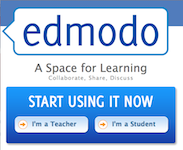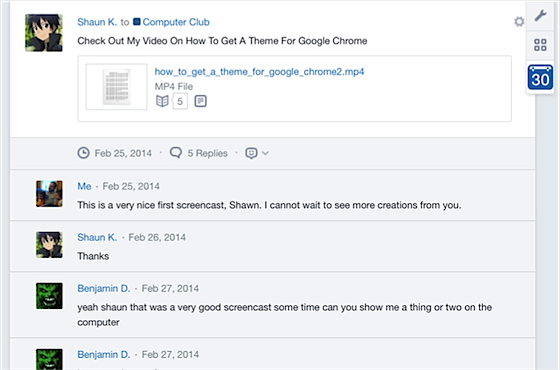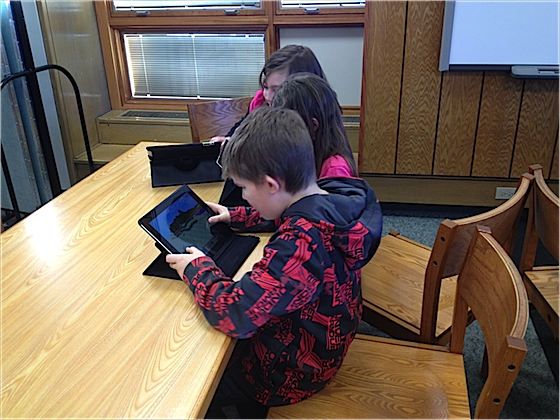Principal Matt Renwick is sharing weekly reflections about an afternoon computer club he and a teacher are sponsoring as an enrichment activity. (Here are the links to this eight-part series: Part 1, Part 2, Part 3, Part 4, Part 5, Part 6 and Part 7 and Part 8.)
I was walking the hallways, like I do every day as the school’s principal, when a 3rd grader caught my eye. While heading the other way with his class, he whispered: “I can’t wait for computer club!” I smiled and responded, “Me either!” Very nice, especially since it was Monday, and our next session was Tuesday evening.
Our after-school enrichment club is starting to hit its groove. Now down to a little over forty students, we have developed a good routine. Grab a snack, have a seat for a brief mini-lesson, take attendance, and then disperse to our iMacs and iPads.
Students have lots of latitude to select the digital tool they want to engage and create with. Collaborations happen naturally. Students can join each other’s Minecraft worlds, provided they follow the creator’s rules.
 They can also connect with each other within our new Edmodo group. This learning management system, adopted after a few weeks of trying other options, gives students a safe place to post their questions or comments, as well as provide feedback and support from each other.
They can also connect with each other within our new Edmodo group. This learning management system, adopted after a few weeks of trying other options, gives students a safe place to post their questions or comments, as well as provide feedback and support from each other.
Pushing some envelopes
Since our kickoff, my teaching partner and I have liked what the kids were doing. But we also felt the need to push the envelope a little bit more. Now that they have had time to explore several of the digital tools available, was there a particular one that could have a profound impact on many other areas?
They liked Minecraft (of course). They also liked exploring YouTube for tutorials and music videos. What if we taught them how to create a screencast? This tool, used to record visuals and audio for the purpose of teaching someone something, is very easy to grasp. It can apply to just about any area of interest, and it’s great for quick sharing.
While the two of us were becoming more learners than teachers, we also wanted to move our students to become teachers for each other. Our learning environment needed more balance. We kicked off our new week by showing students how to create tutorials using Screencast-o-matic, a free web-based tool.
Instead of an aerial overview of what we did next, it might be helpful to more closely observe three of our students. Each of them demonstrated “how to do one thing really well” and thereby helped increase our group’s collective intelligence.

Passion Profile #1: Shaun
Shaun is a 5th grader, very quiet but always alert. After my mini-lesson, he went right to work. His first screencast, about changing your theme within your Google profile, had little sound. I watched it after he posted it on Edmodo and offered recognition for his initial effort.
He must have found the mic on his computer, because his second attempt was much more audible. For his third screencast, he actually created a tutorial that taught others how to create an account on Edmodo. Very thoughtful! I commented on his work and assigned a badge to his profile.
 How Shaun kept at it — continuing to improve upon his skills after the initial tries didn’t pan out — is a hallmark of life long learners. This persistence in learning something new, referred to as iteration, or repeating a process until a desired goal is achieved, is a concept that Marsha Ratzel highlights in her book Teaching in High Gear (Powerful Learning Practice, 2013).
How Shaun kept at it — continuing to improve upon his skills after the initial tries didn’t pan out — is a hallmark of life long learners. This persistence in learning something new, referred to as iteration, or repeating a process until a desired goal is achieved, is a concept that Marsha Ratzel highlights in her book Teaching in High Gear (Powerful Learning Practice, 2013).
Marsha provides many examples and explanations of her disposition toward learning throughout the text. “My students’ strength meant they were willing to dig down deep when what they really wanted was to quit. Some people never learn that finding the answer or doing something successful is mostly overcoming fear that it can’t be done” (p 95).
Like Marsha’s students, Shaun was also willing to dig deep. He saw the joy in his work instead of failure. It helped that his progress was visible, thanks to technology, prompt feedback and reflection.
Passion Profile #2: Tim
Tim was also interested in creating screencasts. However, just one session of me modeling this skill didn’t provide him with the necessary support to be successful. His first two attempts at screencasts lacked sound. When Tim finally did get a screencast to work, he neglected to notice the questionable content in the margins of the webpage he recorded. I promptly deleted the screencast, with hope that he would try again.
Fortunately, like Shaun, Tim did keep at it. This skill didn’t come as quickly for him, but he did end up sharing a screencast on how to create a Google Doc. I think having Tim see Shaun produce quality media via Edmodo gave him a valuable glimpse at what was possible. It motivated him to not give up. I don’t know if it would have been the same if an adult modeled this skill for him again. He had to see a kid his age do it. This is the positive power of peer influence.

Passion Profile #3: Emily
Emily is a 3rd grader, two years younger than Shaun and Tim. What she lacked in experience, she made up for it in enthusiasm. Emily also created an initial screencast; the audio worked perfectly! Her topic: How to find favorite music videos and Minecraft tutorials on YouTube. She also offered affirmations to other students in Edmodo (“You are bright!”) and even posted platitudes (“You may have a bad day, but you can change it.”). Is she a natural for Twitter or what?
Learning Takes Time
We’ve now spent three sessions modeling and guiding students as they went about producing screencasts. On the third night, I attempted to show them how to take screenshots of their scenes in Minecraft on their iPads, and then upload those images to Edmodo for a later screencast.
During my instruction, my co-teacher asked, “How are they going to create screencasts if they are on the iMacs today?” Good point. But instead of fumbling through reverse gear, or pretending I didn’t make a mistake, I acknowledged that I needed to rethink this approach.
The kids nodded, and then went back to their work. The principal needs learning time too.
Matt Renwick
Latest posts by Matt Renwick (see all)
- How Do Digital Portfolios Help Students Learn? - August 1, 2014
- Should We Unconnect from Our PLNs Over Summer Break? - July 3, 2014
- Passion-Based Learning, Week 8: The End of the Beginning - April 30, 2014


Matt, thanks for sharing this insightful piece. At Big Picture Learning (www.bigpicture.org) we believe that learning should happen “one student at a time” and we start with students interests and passions. Great to hear about how your work is aligned.
Would love to hear your thoughts about this – http://www.leavingtolearn.org/10-expectations/
Thanks again!
I have seen that video before and appreciate its message. What I struggle with, in terns of this type of media, is how easy it is to say “personalize your instruction for student learning” without consider all of the mitigating factors that can interfere with this process, such as tech difficulties or lack of access. I fear this type of message can lead to some teachers wondering, “Maybe my instruction is poor because I am not doing that.” This should not be an outcome. My purpose and hope in sharing our regular reflections from our computer club is to provide readers with a more realistic look at project-based learning, from both a classroom and student point of view.